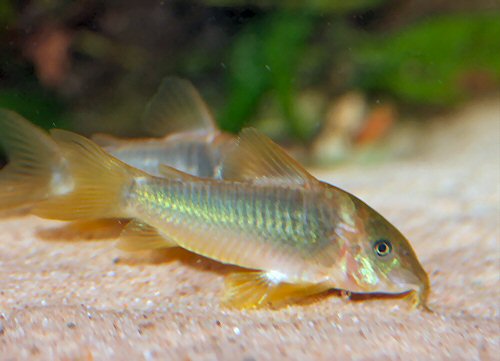SCOTCAT.COM
your internet guide to all things catfish
| Breeding Corydoras melanotaenia |
by Mark Bryson |
Osteogaster melanotaenia
I bought the fish at Huddersfield Aquatics 6th March 1999, on one of our club raiding trips south of the border. This is an excellent outlet that caters mainly for cichlids and catfish species, all wild caught. Four males (3.5cm) and two females approximately 5cm body size were purchased at what I thought was a bargain at £2.50 each. When I returned home I set them up in a 45cm x 30cm x 30cm quarantine tank. Temperature 22c, pH 6.5. Filtration was by an air operated Bio 45 sponge and a corner box filter filled with ceramic pipes and crushed coral (this prevents the pH from dropping too low). Tank also included a small glass trough filled with fine sand and planted heavily with Java fern. Java moss was weighed down and placed on top of a piece of slate (10cm x 15cm). On the slate I had attached small feet, this allowed the fish a hiding place and some security as I found them to be very skittish. They were fed at least twice daily on a mixed diet of live whiteworm, grindal worm, Tetra Prima & Tetra Tabi Min. The fish were maintained in the above conditions until 4th July 1999. I then re-located their tank to a higher position in the fish hut, doing this automatically increased the temperature by two degrees as the hut is space heated. I let things settle down for three weeks and then decided to have a go at getting them to breed. (It’s the old story, you talk to other aquarists who say they have bred Corydoras melanotaenia years and years ago without any problems, but they never really enlighten you as to how they did it). I was doing my weekly 25% water changes to all my tanks, when I got to the melanotaenia tank. I did a 40% change using water straight from the domestic supply, pH 8.3, temperature below 16C. Fortunately this had no adverse effect on the fish, quite the reverse as 72 hours later (29th July) they had spawned. Water parameters at time of spawning were Temp 20c - pH 6.9. Spawning: Day
2. All eggs
had now changed colour to light tan, some were eyeing-up.
Only six eggs fungused in all of the show tanks,
these were removed. Summary
This article was written for Paisley & District Aquarist Society, Catfish Study Group UK (formally The Nothern Area Catfish Group) and Allan James' website ScotCat. Update: Lineage: Placed in Lineage 7 alongside other members of the so called "aeneus group" with the designated type species: C. eques. A revision in the future would constitute the resurrection of the genus name Osteogaster. As of the latest update Corydoras melanotaenia has now been placed in Lineage 7 and has the new genus name of Osteogaster (2024).
|
If you would like to contribute an article, please e-mail me. You will of course be credited for your work.
If you would like to donate any denomination of money to the site just click the above link button. All proceeds will go to running the site and hopefully to keep it going for a few years yet.
Print or e-mail this factsheet below


